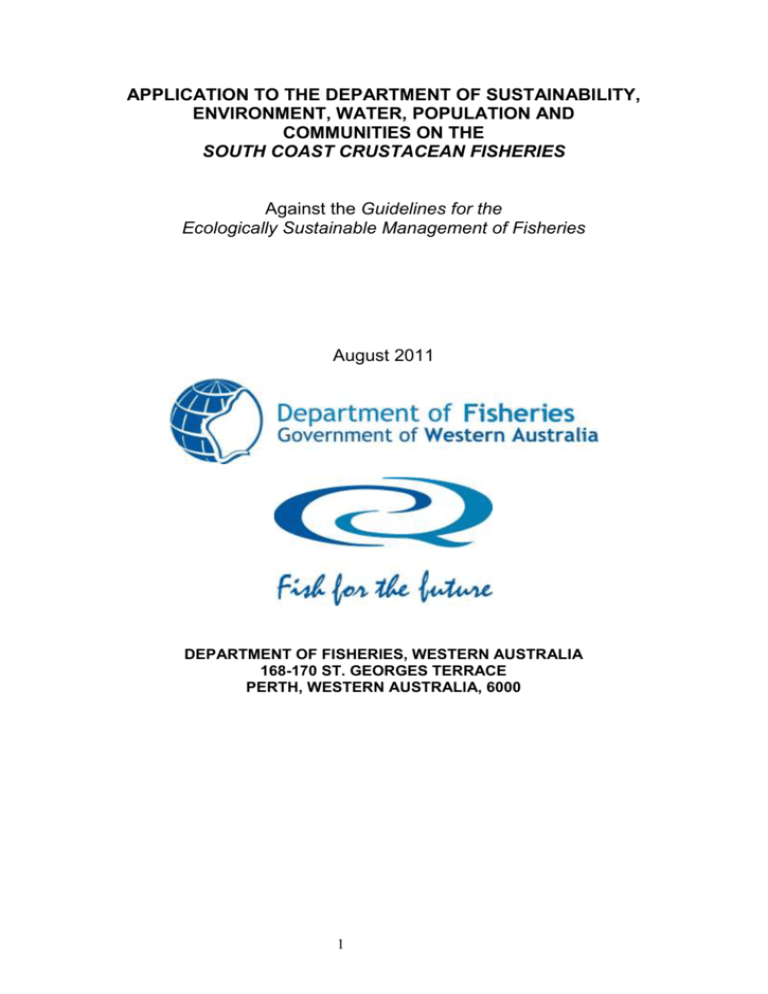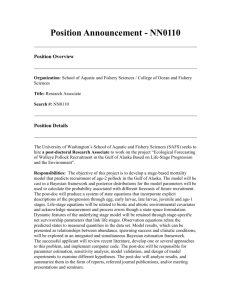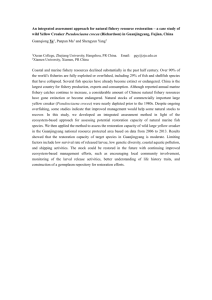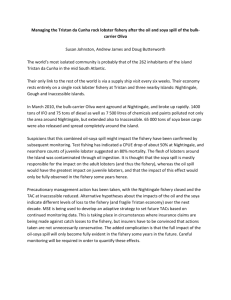Application to DSEWPAC on the South Coast Crustacean fisheries
advertisement

APPLICATION TO THE DEPARTMENT OF SUSTAINABILITY, ENVIRONMENT, WATER, POPULATION AND COMMUNITIES ON THE SOUTH COAST CRUSTACEAN FISHERIES Against the Guidelines for the Ecologically Sustainable Management of Fisheries August 2011 DEPARTMENT OF FISHERIES, WESTERN AUSTRALIA 168-170 ST. GEORGES TERRACE PERTH, WESTERN AUSTRALIA, 6000 1 TABLE OF CONTENTS BACKGROUND ...................................................................................................................... 2 1. SUMMARY OF CHANGES IN THE FISHERY ............................................................. 4 2. PROGRESS IN IMPLEMENTING CONDITIONS ........................................................ 5 3. PROGRESS AGAINST RECOMMENDATIONS ........................................................... 7 APPENDIX 1 – STATE OF THE FISHERIES 07/08ERROR! BOOKMARK NOT DEFINED. APPENDIX 2 – STATE OF THE FISHERIES 08/09ERROR! BOOKMARK NOT DEFINED. BACKGROUND The purpose of this report is to update the Department of Sustainability Environment, Water, Population and Communities (SEWPaC) on changes in the Western Australian South Coast Crustacean Fishery (the Fishery) to enable the re-assessment of the Fishery against the Guidelines for Ecologically Sustainable Management of Fisheries, under Part 13 and 13A of the Environment Protection and Biodiversity Conservation Act 1999 (EPBC Act). 2 Previous Assessments In May 2004, the WA Department of Fisheries (DoF) submitted an application to the Department of Environment and Heritage for assessment of the Fishery against the Guidelines for the Ecologically Sustainable Management of Fisheries, seeking continued listing under section 303DB of the EPBC Act. On 17 September 2004, the then Minister for the Department of Environment and Heritage approved an amendment to the list of exempt native specimens to include all product taken in accordance with the Fishery, including southern rock lobster (Jasus novaehollandiae and edwardsii), western rock lobster (Panulirus cygnus), crystal crabs (Chaceon spp), giant crabs (Psuedocarcinus gigas) and champagne crabs (Hypothalassia armata), and declared the Fishery an approved Wildlife Trade Operation (WTO) under part 13A of the EPBC Act until 20 September 2007. The approval was subject to 10 recommendations. In August 2007 the Department submitted another application for assessment against the guidelines, this time to the Department of Environment and Water Resources. On 9 November 2007, the Delegate of the then Minister, declared the Fishery an approved WTO until 16 July 2008. This short term declaration was based on concerns regarding declining catch rates, the significant amount of latent effort, the lack of robust performance measures and indicators, and insufficient data collection. To address the concerns in the immediate term, the declaration was subject to a condition requiring the Department to publicly release a discussion paper on proposed new management arrangements to address these issues and identify a way forward for improving the ecological sustainability of the fishery. Following release of the discussion paper the WTO was extended to 30 September 2010. In September 2010 a variation to extend the end date to 30 September 2011 was approved to allow more time to implement proposed management arrangements. A copy of the DoF application and the SEWPaC assessment reports and letters of approval are available on the SEWPaC website http://www.environment.gov.au/coasts/fisheries/wa/south-coast-crustacean/index.html Re- Assessment Process This report provides responses to the four conditions arising from the latest Ecologically Sustainable Development assessment, outlining what has been achieved in addressing each condition. The documentation attached to enable re-assessment of the Fishery consists of: a summary of the key changes that have occurred in the Fishery in the past three years; a report addressing the progress of the Fishery against three recommendations of the previous approval; and a copy of the Fishery’s annual reports, published in the annual State of the Fisheries Report over the past two years (appendix 1 & 2); Contact This report should provide sufficient information for SEWPaC to re-assess the Fishery against the guidelines for Guidelines for the Ecologically Sustainable Management of Fisheries - 2nd Edition, under Part 13 and 13A of the EPBC Act 1999. However, should you require any further information regarding the details of the contents of this report please contact Kevin Donohue on (08) 94827 362 or via email Kevin.Donohue@fish.wa.gov.au. 3 1. SUMMARY OF CHANGES IN THE FISHERY Effort in the fishery has remained stable and low, consistent with previous seasons. The continued low effort combined with fishing activity being limited to a small proportion of the fishery has kept risk levels to the environment and to the species taken as part of the Fishery very low. The Department has been working to progress the management arrangements outlined in Fisheries Management Paper 232 released in 2009. Consultation on the proposals within the paper has been completed with only minor amendments being made to some proposals. In keeping with the proposals of FMP232 a panel was formed to provide the Chief Executive Officer with advice on access and allocation to the Fishery. The panel subsequently provided a list of recommendations for ongoing access and allocation, these recommendations have been provided to the peak industry body and distributed to industry. The peak industry body subsequently advised the Department that it believed that there needed to be more engagement with industry on the panel’s recommendations. The Department is currently in dialogue with the peak industry body regarding a revised industry engagement process. 4 2. PROGRESS IN IMPLEMENTING CONDITIONS 1. Operation of the fishery will be carried out in accordance with the SCCF management regime in force under the Fish Resources Management Act 1994. The Fishery continues to operate under the Fish Resources Management Act 1994 and the Fish Resources Management Regulations 1995 and other subsidiary legislation. Fishing for rock lobster in the Esperance and Windy Harbour/Augusta areas of the south coast continues to be regulated under the existing Esperance Rock Lobster and Windy Harbour/Augusta management plans. 2. Department of Fisheries, Western Australia (DFWA) to advise the Department of the Sustainability, Environment, Water, Population and Communities (SEWPaC) of any intended change to the SCCF management arrangements that may affect the assessment of the fishery against the criteria on which EPBC Act decisions are based. There have been no changes to management arrangements that affect the assessment of the Fishery against the criteria on which the EPBC Act decisions are based. 3. DFWA to produce and present reports to the SEWPaC annually as per appendix B to the Guidelines for the Ecologically Sustainable Management of Fisheries – 2nd Edition. These reports have been provided to SEWPaC and have also been attached to this document for completeness. 4. By September 2010, DFWA to implement new proposed management arrangements in the SCCF that will improve the ecological sustainability of the fishery and seek to address the sustainability issues outlined in the “The South Coast Crustacean Fishery – A Discussion Paper”. In relation to Fisheries Management Paper 232, “The South Coast Crustacean Fishery” the consultation phase with the general public including targeted consultation with industry participants and peak bodies in the recreational and commercial fishing sector has been completed by the Department. The proposals presented in the discussion paper were generally supported by those who responded with only minor amendments being made. In accordance with proposal 14 within the paper the Department appointed a panel to provide advice on access and allocation for the Fishery. The panel met on several occasions and produced a series of recommendations on reducing access to the Fishery and how fishing entitlements could be allocated. The primary criteria for reducing access to the Fishery was based on catch history as suggested within FMP232 and at previous meetings with industry. 5 A summary of the panel’s recommendations were forwarded to the peak commercial fishing industry body, the Western Australian Fishing Industry Council (WAFIC) for further consultation with industry. WAFIC distributed the panel recommendations to industry for comment and recent feedback from WAFIC has indicated industry members would like the opportunity to present to the panel either directly or via written form. The Department is in dialogue with WAFIC regarding a revised industry engagement process. 6 3. PROGRESS AGAINST RECOMMENDATIONS 1. DFWA to develop and implement a robust system to validate commercial logbook reporting of catch and effort for all target and byproduct species. The introduction of the new management plan will also include a legislative requirement for fishermen to complete a trip log book similar to those already used in the West Coast Deep Sea Crab Fishery. This book will be verified from time to time by compliance officers when carrying out an unload inspection. In the meantime the Department will continue to collect information from commercial fishers on catch and effort through the existing mandatory monthly catch and effort returns. 2. By September 2010 DFWA to: a. review risk levels for target species, byproduct, bycatch (including protected species) and impacts on the marine environment for the SCCF incorporating the proposed management arrangements into the review; and b. where appropriate, update or develop new objectives, performance measures, management responses and information requirements for target species, byproduct, bycatch (including protected species) and the marine environment. The date specified in the above recommendation was based around the expected introduction of a new management plan for the Fishery. The Department concurs with the recommendation but due to the delay in the introduction of the management plan and low levels of fishing, it has not reviewed risk levels. Due to the very low effort in the fishery and the small percentage of available area that is actually fished the Fishery is considered to be a low risk fishery both to the environment and to all species affected. Due to the changes expected to come with the introduction of a new management plan, the Department will commit to completing a risk review when the new management plan is introduced. 3. By September 2010, DFWA to develop a research strategy for the SCCF, in order to identify and prioritise key research needs to meet the management, stock assessment and performance measurements needs of the fishery. Until long term management and reporting requirements are in place it is difficult for researchers to establish a research strategy for the Fishery. Due to the low level of fishing effort it is considered to be a very low risk fishery and accordingly the Department cannot justify any research beyond an annual catch and effort review at this stage. The introduction of a new management plan and more detailed log book will allow a more detailed catch and effort review to be carried out in the future. 7 8





